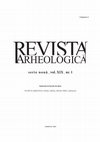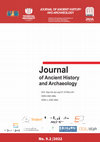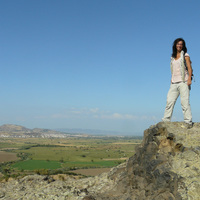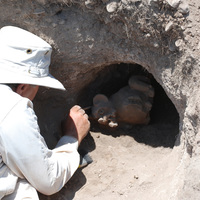Papers by Hülya Çalışkan Akgül
Bir İdealin Peşinde: Atatürk ve Alaca Höyük, 2023

REVISTA ARHEOLOGICĂ, 2023
New finds at the sites of Koskarlı and Kaledere caves near Trabzon have shown a connection betwee... more New finds at the sites of Koskarlı and Kaledere caves near Trabzon have shown a connection between these sites and finds of bipolar retouched lunates. Such lunates are known from the Near East (Late Natufian Culture), Antalya and Cappadocia
(Karain B сulture), the east coast of the Aegean Sea, Lemnos Island, the Sea of Marmara, and the Crimea. All known sites with lunates are associated with the Late Pleistocene. A study of the sites of Koskarlı and Kaledere has shown that the technology of bipolar retouched lunates production also spread to the southeastern Black Sea region. Finds from the Trabzon caves have led to a re-evaluation of several sites in western Georgia where lunates of this type have also been found. All the sites were located at a short distance from the seacoast. This circumstance suggests that in the second half of the XIII-XI millennium B.C. there was a maritime cultural and historical area that was the result of migratory activity. The center of the resettlement was the Antalya region. The migration of the carriers of this industry preceded the beginning of the neolithization process in the coastal areas of the four seas.

The Trabzon Archaeological Survey Project was initiated in 2018 with the aim of researching the p... more The Trabzon Archaeological Survey Project was initiated in 2018 with the aim of researching the pre-Classical Period in the southeastern Black Sea region. This is a period which had not received much attention previously from researchers. In the first two years of the field researches, some archaeological sites (Kalecik/Mile Castle, Konakdüzü area, ruins in the Horhor and Sumaha hills) within the boundaries of the Maçka district have been discovered, and they were attributed to an early period. These archaeological sites and some of the material remains obtained here are thought to belong to the local peoples of the region mentioned in ancient Greek and Roman texts. The survey project reveals some significant results in compare of descriptions about the local peoples in ancient texts and archaeological evidence of the contemporary neighboring cultures. Thus, it can be said that for the first time, archaeological evidence about the ancient peoples in the region has been obtained.

Sette Città, 2020
In the Anatolian ceramic repertoire of the Late Chalcolithic period, high-stemmed bowls called &a... more In the Anatolian ceramic repertoire of the Late Chalcolithic period, high-stemmed bowls called 'fruit-stands' form a group of vessels for which the function is mostly unknown. This group of bowls from the Late Chalcolithic period is best known in the settlements of the Kızılırmak basin, and the Upper Euphrates region in Anatolia. Although the results of archaeological studies in the Upper Euphrates region reveal a clearer picture, the fragmented structure and restricted data of the Chalcolithic period in the Kızılırmak basin present a bigger challenge. However, despite this data from the Kızılırmak basin shows that the described form cannot be included in the 'daily vessel' class. This study focuses on high-stemmed bowls as significant indicators of communication and interaction between the Upper Euphrates region and the Kızılırmak basin at the end of the 4th millennium BC, and the possibility that they were used as ritual vessels instead of for daily usage.
KARADENİZ ARAŞTIRMALARI ENSTİTÜSÜ DERGİSİ, 2022

G. Finlay wrote that "the history of Trebizond was almost unknown, until Professor Fallmerayer di... more G. Finlay wrote that "the history of Trebizond was almost unknown, until Professor Fallmerayer discovered the Chronicle of Michael Panaretos". After the discovery of these chronicles, while the history of the Kingdom of Komnenos, which was established in 1204, began to be enlightened, also the interest in the history of the entire region was increasing. Thus, all the information about Trabzon and its surroundings, which were mentioned in ancient sources throughout the 19th century, began to be brought together. As a result of these efforts, a judgment has emerged that Trabzon took its place in the history scene in the 1st millennium BC as a "Greek colony". Now, although we do not say that "the history of the town is still almost unknown", it is clear that there are quiet many unknown things about this subject. Although the main subject of this paper is so called "Hadrian Port" which we got the opportunity to examine fortuitously during the archaeological survey conducted in the city centre in 2018, taking this opportunity, most of the things that have been said and written about the history of Trabzon since Xenophon have been studied once again. In this way, information about this famous city and its historical port on the southeastern coast of the Black Sea has been put on the table.
Archaeological Research in Asia, 2021

Karadeniz İncelemeleri Dergisi, 2021
G. Finlay wrote that "the history of Trebizond was almost unknown, untilProfessor Fallmerayer dis... more G. Finlay wrote that "the history of Trebizond was almost unknown, untilProfessor Fallmerayer discovered the Chronicle of Michael Panaretos”. After thediscovery of these chronicles, while the history of the Kingdom of Komnenos,which was established in 1204, began to be enlightened, also the interest in thehistory of the entire region was increasing. Thus, all the information about Trabzonand its surroundings, which were mentioned in ancient sources throughout the 19thcentury, began to be brought together. As a result of these efforts, a judgment hasemerged that Trabzon took its place in the history scene in the 1st millennium BCas a "Greek colony". Now, although we do not say that "the history of the town isstill almost unknown”, it is clear that there are quiet many unknown things aboutthis subject. Although the main subject of this paper is so called “HadrianPort” which we got the opportunity to examine fortuitously during thearchaeological survey conducted in the city centre in 2018, taking this opportunity,most of the things that have been said and written about the history of Trabzonsince Xenophon have been studied once again. In this way, information about thisfamous city and its historical port on the southeastern coast of the Black Sea hasbeen put on the table.
Anadolu Araştırmaları, 2020

Pathways through Arslantepe. Essays in Honour of Marcella Frangipane, 2020
In the Anatolian ceramic repertoire of the Late Chalcolithic period, high-stemmed bowls called 'f... more In the Anatolian ceramic repertoire of the Late Chalcolithic period, high-stemmed bowls called 'fruit-stands' form a group of vessels for which the function is mostly unknown. This group of bowls from the Late Chalcolithic period is best known in the settlements of the Kızılırmak basin, and the Upper Euphrates region in Anatolia. Although the results of archaeological studies in the Upper Euphrates region reveal a clearer picture, the fragmented structure and restricted data of the Chalcolithic period in the Kızılırmak basin present a bigger challenge. However, despite this data from the Kızılırmak basin shows that the described form cannot be included in the 'daily vessel' class. This study focuses on high-stemmed bowls as significant indicators of communication and interaction between the Upper Euphrates region and the Kızılırmak basin at the end of the 4th millennium BC, and the possibility that they were used as ritual vessels instead of for daily usage.
Türk Eskiçağ Bilimleri Enstitüsü Haberler, 2020
Araştırma Sonuçları Toplantısı, 2019
Aktüel Arkeoloji 73, 2020
ARKEOLOJİYLE GEÇEN YARIM ASIR: SEVİL GÜLÇUR ARMAĞANI, 2019
Doğu Karadeniz'de Toplumsal Yapı, Kültür ve Gündelik Hayat, 2018

The approximation of the raw material source as well as the minimum and maximum firing temperatur... more The approximation of the raw material source as well as the minimum and maximum firing temperatures in the pottery production technology can be determined depending on the mineralogical and chemical changes in the ceramic components. For the determination various analytical techniques are used such as Xray diffraction (XRD), thermal analysis (TGA-DT), Scanning electron microscope (SEM), X-ray fluorescence spectrometry (XRF) and inductively coupled plasma (ICP). In this paper the possible clay resources of Halaf pottery from Tilkitepe is required to determine. The analyzed pottery fragment and the clay samples were collected around the mound. Experimental studies were carried out at temperatures of 600 o C, 700 o C, 800 o C and 900 o C. The results show that the Halaf type ceramic piece from the mound is most probably made using local clay sources in the region and fired at temperatures below 800 °C under oxidation conditions.

As a phenomenon in Anatolian archaeology the red-black burnished ware has long been
defined as be... more As a phenomenon in Anatolian archaeology the red-black burnished ware has long been
defined as being of Transcaucasian origin. The ware with this color scheme is generally dated to the
Early Bronze Age. However, this assumption now seems to be changing in view of the results of fiftyyear
of excavations at Arslantepe. The dating of the earliest examples of this type of pottery to the last
phase of the Late Chalcolithic and the identification of a resemblance of this pottery to a type in Central
Anatolia – especially from the bend of the Kızılırmak River at sites like Alişar and Alaca Höyükhas
diverted attention westward from Eastern Anatolia. Central Anatolia has now become a crucial
location for gaining a better understanding of this phenomenon. Nevertheless the character, formation,
evolution and influence of this relation, dated to the end of the 4th and beginning of the 3rd millennium
BC, is not yet clear.











Uploads
Papers by Hülya Çalışkan Akgül
(Karain B сulture), the east coast of the Aegean Sea, Lemnos Island, the Sea of Marmara, and the Crimea. All known sites with lunates are associated with the Late Pleistocene. A study of the sites of Koskarlı and Kaledere has shown that the technology of bipolar retouched lunates production also spread to the southeastern Black Sea region. Finds from the Trabzon caves have led to a re-evaluation of several sites in western Georgia where lunates of this type have also been found. All the sites were located at a short distance from the seacoast. This circumstance suggests that in the second half of the XIII-XI millennium B.C. there was a maritime cultural and historical area that was the result of migratory activity. The center of the resettlement was the Antalya region. The migration of the carriers of this industry preceded the beginning of the neolithization process in the coastal areas of the four seas.
defined as being of Transcaucasian origin. The ware with this color scheme is generally dated to the
Early Bronze Age. However, this assumption now seems to be changing in view of the results of fiftyyear
of excavations at Arslantepe. The dating of the earliest examples of this type of pottery to the last
phase of the Late Chalcolithic and the identification of a resemblance of this pottery to a type in Central
Anatolia – especially from the bend of the Kızılırmak River at sites like Alişar and Alaca Höyükhas
diverted attention westward from Eastern Anatolia. Central Anatolia has now become a crucial
location for gaining a better understanding of this phenomenon. Nevertheless the character, formation,
evolution and influence of this relation, dated to the end of the 4th and beginning of the 3rd millennium
BC, is not yet clear.
(Karain B сulture), the east coast of the Aegean Sea, Lemnos Island, the Sea of Marmara, and the Crimea. All known sites with lunates are associated with the Late Pleistocene. A study of the sites of Koskarlı and Kaledere has shown that the technology of bipolar retouched lunates production also spread to the southeastern Black Sea region. Finds from the Trabzon caves have led to a re-evaluation of several sites in western Georgia where lunates of this type have also been found. All the sites were located at a short distance from the seacoast. This circumstance suggests that in the second half of the XIII-XI millennium B.C. there was a maritime cultural and historical area that was the result of migratory activity. The center of the resettlement was the Antalya region. The migration of the carriers of this industry preceded the beginning of the neolithization process in the coastal areas of the four seas.
defined as being of Transcaucasian origin. The ware with this color scheme is generally dated to the
Early Bronze Age. However, this assumption now seems to be changing in view of the results of fiftyyear
of excavations at Arslantepe. The dating of the earliest examples of this type of pottery to the last
phase of the Late Chalcolithic and the identification of a resemblance of this pottery to a type in Central
Anatolia – especially from the bend of the Kızılırmak River at sites like Alişar and Alaca Höyükhas
diverted attention westward from Eastern Anatolia. Central Anatolia has now become a crucial
location for gaining a better understanding of this phenomenon. Nevertheless the character, formation,
evolution and influence of this relation, dated to the end of the 4th and beginning of the 3rd millennium
BC, is not yet clear.